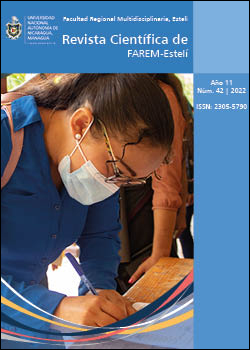Mariana apparitions in common objects and spaces at the end of the 20th century in Mexico
DOI:
https://doi.org/10.5377/farem.v11i42.14682Keywords:
Apparitions, religious culture, metanarratives, popular religiosityAbstract
The purpose of this paper is to analyze the Marian apparitions in objects and spaces as a religious phenomenon that occurred in the last two decades of the twentieth century in Mexico. Contemporary society in the country has expressed its religious modernity through a singular way that is gaining momentum every day, such as channeling certain myths; elaborating asystemic and deinstitutionalized rituals as a consequence of the re-appropriation of the religious foundational meta-narratives among which the birth and death of Jesus Christ, Marian devotion, among others, stand out. Some social groups have made up the narratives in local collective imaginaries, to which they add a large part of their religious cultural identity. Such is the case of the Marian myth of the Virgin of Guadalupe for its strong content in the construction of the religious cultural identity of Mexican society. However, the massive apparitions of the Virgin Mary in objects and places so unusual, common and every day that these were trivialized. In this sense, the debate will be organized in two conceptual schemes. On the one hand, the called emptying of religion, understanding it as the rethinking of that which is full and which in a certain way explains the trivialization of the stories and apparitions. On the other hand, the elaboration of universes of recognition rather than of knowledge, where the appropriation of the places of transit and the process of unanchoring reveals the urgency of recovering the certainty forgotten by the contemporary nomad.
Downloads
References
Augé, M. (2000). Los no lugares: espacios de anonimato. Una antropología de la sobremodernidad. Gedisa.
Bajoit, G. (2003). Todo cambia: análisis sociológico del cambio social y cultural en las sociedades contemporáneas. Ediciones LOM.
Bell, D. (2004). Las contradicciones culturales del capitalismo. Alianza Editorial.
De la Torre, R. (2008). La religiosidad peregrina de los jaliscienses: vírgenes viajeras, apariciones en los no lugares y santos polleros. Emisférica. Traveling Virgins, 5(1). https://hemi.nyu.edu/journal/5.1/esp/es51_pg_delatorre.html
De la Torre, R. y Gutiérrez, C. (2016). Genealogías de la Nueva Era en México. REVER, 16(2), 55-91. DOI: 10.21724/rever.v16i2.29282
Durkheim, É. (1982). Las formas elementales de la vida religiosa. Akal.
Editorial Telediario (13 de julio de 2021). Captan llorando a estatuas de la Virgen de Guadalupe en diferentes lugares de México. Editorial Telediario. https://www.telediario.mx/tendencias/captan-llorando-estatuas-virgen-guadalupe-lugares-mexico
Giddens, A. (1994). Consecuencias de la modernidad. Alianza.
Gutiérrez, Á. A. (2021). Entre rezos, festejos y disputas por un santo esqueleto. Multi-Ensayos, 7(13), 51-69. DOI: https://doi.org/10.5377/multiensayos.v7i13.10752
Gutiérrez, Á. A. (2020). Juventud, crisis identitaria y globalización de la cultura. Perfiles de las Ciencias Sociales, 8(15), 345-364. https://revistas.ujat.mx/index.php/perfiles/article/view/3919
Gutiérrez, Á. A. (2019). Panorama étnico religioso en México. Ecos Sociales, 7(19), 672-683. https://revistas.ujat.mx/index.php/ecosoc/article/view/3211
Gutiérrez, C. (1996). Nuevos movimientos religiosos: el New Age en Guadalajara. Relaciones, 65/66(17), 89-114. https://www.colmich.edu.mx/relaciones25/files/revistas/065-066/CristinaGutierrezZuniga.pdf
Harvey, D. (1998). La condición de la posmodernidad. Investigación sobre los orígenes del cambio cultural. Amorrortu.
Luhmann, N. (1992). Sociología del riesgo. Universidad Iberoamericana, Universidad de Guadalajara.
Hervieu-Léger, D. (2005). La religión, hilo de memoria. Herder.
Hervieu-Léger, D. (2004). El peregrino y el convertido, la religión en movimiento. Helénico.
Lyotard, J. F. (2006). La condición postmoderna. Cátedra.
Paz, O. (1999). El laberinto de la soledad. Postdata. Vuelta a “El laberinto de la soledad”. Fondo de Cultura Económica.
Sartori, G. (2001). Homo videns. La sociedad teledirigida. Taurus.
Vattimo, G. y otros (2003). En torno a la posmodernidad. Anthropos.
Published
Issue
Section
License
Copyright (c) 2022 Revista Científica de FAREM-Esteli

This work is licensed under a Creative Commons Attribution-NonCommercial-ShareAlike 4.0 International License.



